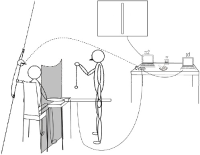
Purpose This study measured the haptic extroperception accuracy, that is, judging one hit position in a hand-held object. Especially, what factors associated the estimation of contact position when the impact is made at the grasped implement by hitting the ball. Methods Relative frequency and conditional probability based analysis verified that perceivers influenced not only the amount of pressure distinguished impressions by the coefficient of restitution but also the pressure distributions encoded impressions by the distance from the hand to the impact. Results Results conformed to previous invariant characteristic on dynamic touch in showing that perceiving the location of the impact of grasped objects, including dominant perceiving selectively modality, is constrained by inertial properties with such success requires appreciating the location of the implement’s center of percussion. Conclusion Investigated in this planes captured as a mechanical factor, we would suggest a broader hypothesis for further research into the effects of the rotational inertia related to haptic position accuracy in the hand-held object, and leading to different estimates of system function providing an account of generalization that accommodates of its varied aspects.





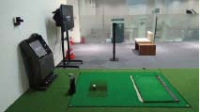
[Purpose] We examined the influence of reactive neuromuscular training (RNT) on golf swing coordination. RNT aims to induce proper coordinative movement by exaggerating the performer’s mistakes. Therefore, we applied RNT using inertia overloading to golfers who have problems with kinematic sequence during a golf swing. [Methods] To examine the effect of 12 weeks of RNT on golf swing coordination, we employed a ball tracking system (launch monitor) and motion analysis system (inertia sensors) were taken on four consecutive periods (pre-test and post-tests 4, 8, and 13 weeks later). Thirty Korean male cadets were divided into three groups based on inertial loading and practiced 7-iron golf swings combined with specific group tasks twice per week. [Results] At pre-test, most participants reached maximal angular velocity near the impact timing (95-100%). However, the deceleration timing of the maximum angular velocity of the proximal segments gradually moved toward mid-downswing as the training sessions proceeded, with the RNT group ultimately outperforming the two control groups. Additionally, the RNT group showed a significantly higher maximum angular velocity in the thorax and wrist. [Conclusion] Our results suggest that RNT can be sufficient to elicit and effective whole-body coordination pattern. Considerable follow-up research is needed on the use of RNT for various sports tasks and the effects of expertise on RNT results.


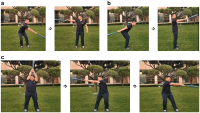
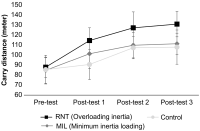
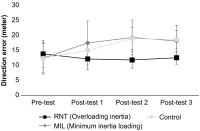



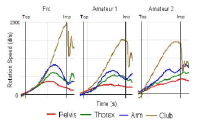
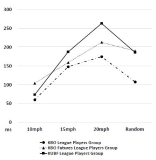
[Purpose] The purpose of this study was to investigate effects of baseball expertise and stimulus speeds on coincidence-anticipation timing accuracy of batting. [Methods] Participants were 21 baseball batters, 7 of Korea Baseball Organization(KBO) League, 7 of Korea Baseball Organization Futures League, and 7 of Korea University Baseball Federation(KUBF) League. All of the participants were asked to swing the bat exactly at the time when the light arrived the target point of the runway. The Bassin Anticipation Timer was used to present stimulus with stimulus speed of 10, 15, and 20mph. Participants performed 10, 15, 20mph trials (3 kinds of speed per 5 times) and random trials (3 kinds of speed per 3 times randomly). The timing error of coincidence anticipation task was recorded and raw scores were transformed to constant error(CE), absolute error(AE) and variable error(VE). For data analysis, two-way ANOVA with repeated measures were used. And post-hoc test (Tukey HDS) were conducted. [Results] Results indicated a significant interaction on expertise and stimulus speeds for CE, AE and VE. The KBO League players group showed more accurate and consistent performance than the KBO Futures League players group and the KUBF League players group in baseball batting timing. [Conclusion] This findings revealed that coincidence-anticipation timing accuracy batting in baseball can be used as a factor to distinguish the ability of the other.


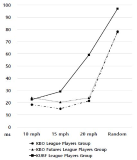
PURPOSE The purpose of this study was to provide information for improving the performance and skills of 500 m speed skaters by analyzing the kinematic and kinetic changes in their slide board movements over time. METHODS The subjects were 10 male short-distance skaters in their 20s to 30s who were registered as professional athletes with the Korea Sports Council. The changes in joint angle, joint moment, and joint power over time in the subjects’ slide board motion were measured and analyzed. RESULTS It was found that during phase 2 of the skater’s slide board movement, there was an increase in plantar flexion and a decrease in flexion of the lower extremity joint and extension of the knee and hip joint, with decrease in positive power of the knee joint. CONCLUSIONS The results of this study are expected to provide practical information to skating coaches and athletes by quantifying the biomechanical factors observed over time during slide board movements. In addition, this study is expected to contribute to the field of speed skating by presenting scientific training methods and proposing new analysis techniques to improve performance in the future.
PURPOSE This study examined the effect of sports life skills and life skills transfer of student-athletes and coaches, applying Actor-Partner Interdependence Model (APIM). METHODS Korean student-athletes and coaches from middle and high school sports teams participated in this study. There were 300 student-athletes (Mage=15.44, SD=1.64; male=218, female=82), with an average of 5.46 (SD=2.40) years of athletic career. Meanwhile, 33 coaches were (Mage=39.70, SD=8.36; male=26, female=7), with an average of 13.52 years of coaching career (SD=10.01). Measures included the Life Skills Scale for Student-Athletes (LSSSA; Jang et al., 2020) and Korean Life Skills Transfer Survey (KLSTS; Lim et al., 2018). Descriptive analysis, correlation, and APIM were undertaken by using the SPSS and AMOS programs. RESULTS First, the correlation between athletes’ and coaches’ life skills was not significant. Second, athletes’ life skills significantly affected their life skills transfer, similar to coaches’ life skills significantly affecting their life skills transfer. Fourth, coaches’ life skills did not significantly influence athletes’ life skills transfer, and the converse was not true either. CONCLUSIONS This study verified the effect of life skills development for two groups of athletes and coaches, on transfer in sports, and attempted statistical verification of whether it affects sports life skills and transfer between athletes and coaches. Although no statistically significant results were found in the partner effect, it is meaningful in that, it provided important implications for conducting a follow-up study on the relationship between athletes and coaches. In other words, it is expected to be a cornerstone for research on building a new model, along with investigating the interactive relations between athletes and coaches on life skills in the sports field.